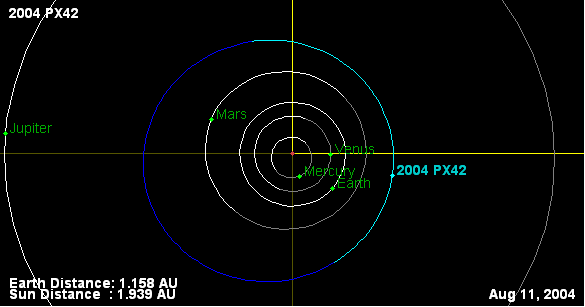the john muir exhibit - geography - minor planet
Minor Planet Named for John Muir
The International Astronomical Union (IAU), through the
Smithsonian Astrophysical Observatory's (SAO) Minor Planet Center (MPC),
has
announced the naming of a newly discovered minor planet in honor of
pioneer
conservationist John Muir. The announcement was made in the June 2006
issue
of the Minor Planet Circular, published by the SAO/MPC. This development
seems an appropriate tribute for someone who gave his address as "Earth-Planet,
Universe!"
The tiny, 1-mile diameter celestial body, now named "Johnmuir",
was
discovered in August 2004 by amateur astronomer R.E. Jones from his
backyard
observatory located in a Los Angeles suburb. Mr. Jones was making
photographic measurements of the position of another small celestial
body -
a near-Earth asteroid discovered by a professional observatory just
the
night before - when he noticed a second, much slower moving object
in his
photographs. A check of catalogues and positions of known objects in
the
Solar System suggested that the second object was likely a new discovery.
Subsequent observations by the Francisquito
Observatory (the name of
Mr.
Jones' observatory in the Santa Clarita Valley) and by professional
observatories including Mt. Palomar in California and Kitt Peak in
Arizona
confirmed the new find, and Francisquito Observatory was credited by
the
IAU/MPC with discovery of Solar System object number 2004PX42.
Below: Diagram showing location of Johnmuir, celestial object 2004PX42,
with respect to Sun, inner planets and Jupiter on date of discovery.

[Image courtesy of Francisquito
Observatory]
Once 2004PX42 had been observed a sufficient number of times to enable the
calculation of a very precise orbit (which occurred in early 2006 following
additional measurements by the Kitt Peak Observatory), Mr. Jones was given
the opportunity to propose a name for his discovery. The name Johnmuir was
submitted to the 15-member Committee on Small Body Nomenclature of the IAU
and approved just prior to publication of the SAO/MPC's June 2006 Minor Planet
Circular.
In the official citation for the name proposal, John Muir is recognized
for
his scientific contributions to the fields of glaciology and botany
in the
late 19th century, and for his tireless promotion of the National Park
concept in the early 20th century. John Muir joins a select group of
individuals who have had small Solar System objects named in their
honor,
including composer Wolfgang Amadeus Mozart, and physicist Albert Einstein.
Discovery Circumstances:
Main Belt asteroid discovered by Francisquito Observatory on 2004.08.11,
in second-night images taken to confirm previous Francisquito main
belt discovery 2004PC27. Brightness measured at magnitude 20.1 at time
of discovery, with a sky motion of 0.30arc-sec/min. Absolute magnitude:
17.2. Distance: 1.158AU. Confirmation observations made on 2004.08.12,
provisional designation issued by MPC on same date. Also observed by
MIT-LINEAR (Socorro, NM) on 2004.08.11. Later linked with single-night
observations by Kitt Peak (Arizona) on 2002.02.06, LPL-Spacewatch (Arizona)
on 2002.02.09, LINEAR on 2002.02.11, and Kitt Peak-Spacewatch on 2000.08.01;
a previous designation of 2002CK262 had been used for one or more of the
single-night observations in 2002. Celestial coordinates: RA 00h 41m 57.35s;
DEC +06deg 29m 49.8s.
For more information :
Richard E. Jones
E-Mail: director@nospam.francisquito.org
www.francisquito.org
June 12, 2006
John Muir Exhibit
Home | Alphabetical
Index | What's
New